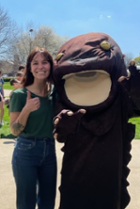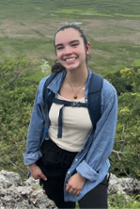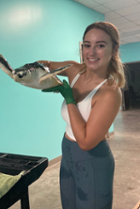Meet the team
Lab Director

Rod Williams
Staff

Eliza Hudson

Nicholas Burgmeier
My work focuses on two separate facets of eastern hellbender conservation: 1) species repatriation and 2) outreach and education. In Indiana, the eastern hellbender population has been reduced to only the Blue River. However, several Ohio River tributaries seem to possess suitable hellbender habitat. I am evaluating the environmental conditions in these tributaries to determine if the habitat, water quality, and food base would be suitable for hellbender repatriation. Expanding hellbender populations to additional suitable habitat will ensure Indiana’s hellbenders are protected from stochastic events and will help restore these river systems to a more functional state.
The second aspect of my work is focused working with landowners to improve water quality. One of the main drivers of hellbender decline (as well as that of many fish and mussels) has been poor water quality and sedimentation. I am developing presentations and programs to help encourage landowners in southern Indiana to adopt practices that will reduce water pollution. If successful, these programs should ultimately help to improve our aquatic resources, including habitat for the hellbender.

Shelby Royal
Undergraduate Students

Arlene Polar

Kylie Soniak

Kevin Rivera

Jena Walker
Former Lab Members
Post Doc
skimble@purdue.edu
Purdue University
Steve’s postdoc is shaping up to truly challenge and broaden the skills he learned as a graduate student. He is currently husbanding eastern hellbenders, directing a disease surveillance study in a captive population of eastern box turtles, mentoring undergraduate and graduate students, learning next generation sequencing, and actively pursuing pedagogical training in university-level instruction.
Steve’s postdoc is shaping up to truly challenge and broaden the skills he learned as a graduate student. He is currently husbanding eastern hellbenders, directing a disease surveillance study in a captive population of eastern box turtles, mentoring undergraduate and graduate students, learning next generation sequencing, and actively pursuing pedagogical training in university-level instruction.
Shelby Royal-Roberts
MS Student
royals@purdue.edu
Purdue University
My research focuses on continuing advancing captive-rearing practices for larval and juvenile Eastern Hellbenders. Many husbandry techniques used for Hellbenders are based on folklore husbandry techniques and lack empirical data. My research focuses on using experimental approaches to learn how tank size, as well as density and food availability affects growth and food consumption for both larval and juvenile Hellbenders. My master’s research will help establish standardized guidelines for captive-rearing programs across the country. In addition, with the ultimate goal of improving Hellbender welfare while in captivity and increasing survival post-release.
Bart Kraus
MS Student
bkraus@purdue.edu
Purdue University
My research is focused on the spatial ecology and survivorship of translocated and resident eastern hellbenders (Cryptobranchus alleganiensis alleganiensis) in the Blue River, IN. Recent population declines throughout their range have prompted concern about the persistence of this species. Indiana’s eastern hellbender population has been restricted to the Blue River, located within one of the southernmost watersheds in the state. Previous telemetry research suggests individuals are scattered throughout the river and/or are spatially isolated from one another. I hope to increase local hellbender population densities using translocations. I will then determine their home range, both temporally and spatially, and dispersal distances (of translocated individuals) in order to help determine the feasibility of hellbender translocations.
Additionally, I would like to estimate the survivorship of both translocated and resident hellbender to determine translocation success and to inform state management agencies when deciding on the future conservation efforts for this species.
Nick Burgmeier
MS Student
nburgmei@purdue.edu
Purdue University
My research is focused on various life history attributes and the population status of the eastern hellbender (Cryptobranchus alleganiensis alleganiensis) in the Blue River, IN. Recent range wide declines have prompted concern about the potential viability of the species. In Indiana they are known to exist only in the Blue River, though extensive surveys have not been conducted elsewhere. I hope to determine the home range and habitat use, both seasonally and spatially, in order to better understand the needs of the species. Additionally, I would like to estimate the remaining population size to help management agencies determine the proper course of action within the state. With help from another graduate student, we would also like to attempt exhaustive surveys in other lotic systems in an effort to locate any remaining populations.
I’m also interested in the parasite loads these individuals possess as well as the potential contribution of xenobiotics to the decline the of the Indiana populations.
Andrea Currylow
MS Student
currylow@purdue.edu
Purdue University
I am interested in conservation and behavioral ecology, particularly of terrestrial turtles. In my work I would like to incorporate modern and traditional conservation approaches, such as molecular techniques paired with population biology and life history data, to inform conservation of species. My Master’s research project focuses on the behavioral effects of various timber harvesting regimes on an Indiana Species of Special Concern, the eastern box turtle (Terrapene carolina carolina). Forest habitats are known to serve as refugia for a variety of species in both fragmented and contiguous landscapes. To this end, timber harvesting is likely one of the most prominent land uses effecting forest wildlife. Box turtles are geographically widespread throughout the eastern forests, and are particularly sensitive to environmental variation that effects the ground habitat they occupy. Because turtles are k-selected (long-lived with low effective annual reproductive rates), negative impacts to population structure can devastate a population while going undetected for decades.
Steven Kimble
PhD Student
skimble@purdue.edu
Purdue University
For his dissertation Steve quantified the genetic population structure of the eastern box turtle from the scale of a single forest to the entire species range. He found that population structure operates at much greater geographic extents than had been predicted. There are two populations rangewide, separated roughly by the Appalachian Mountains. At the single forest scale, he found that > 90% of individuals sampled were unrelated to each other, despite the conserved home ranges of adults and putatively low dispersal ability of eastern box turtles. However, he found that parent-offspring pairs were on average 10.6 km apart, suggesting some sort of dispersal occurs. Finally, he found evidence to suggest that across the highly fragmented Midwest, riparian corridors may be used as conduits for gene flow.
Jami Macneil
MS Student
jmacneil@purdue.edu
Purdue University
My master’s research is focused on the effects of timber harvests on woodland salamanders. The species in the family Plethodontidae serve as ideal indicators of forest ecosystem integrity in the eastern United States. Terrestrial salamanders exhibit cutaneous respiration, small home range, and low dispersal ability, all of which make them sensitive to environmental changes. They also play an important role in nutrient cycling, and their high densities relative to other forest vertebrates make them relatively easy to monitor. Nevertheless, the response of these species to various types of timber management techniques is not well understood. Impacts on behavior, abundance, demography, and species composition, as well as time to recovery, may depend on the type of management used.
Shem Unger
PhD Student
sunger@purdue.edu
Purdue University
My PhD research is on the ecology, genetic variation, and population status of the eastern hellbender (Cryptobranchus alleganiensis alleganiensis) in the Blue River, IN. These long-lived salamanders inhabit clear, cool streams with a mosaic of larger shelter rocks and gravel substrate for nest construction and larval development. Hellbender populations are in severe decline throughout their range due to increased siltation, water pollution, over-collection, and mortality by anglers. Indiana populations once found throughout the Wabash and Ohio River watersheds, are now restricted to the Blue River. Because this decline is likely the result of multiple causative agents, we will utilize a combination of field sampling techniques, laboratory simulation, and molecular marker development to investigate hellbender ecology and genetics.
Obed Hernandez-Gomez
PhD Student
herna102@purdue.edu
Purdue University
I am interested in studying the immunogenetics of hellbenders. The Ozark hellbender subspecies is currently listed as endangered, and has been documented to have an increased rate of infections that lead to necrosis of the limbs and other infected areas. This pattern has not been noted on the other subspecies of hellbenders, the eastern hellbender. However, both subspecies have suffered significant population number loss within the past 30 years. I plan to first identify the bacterial and fungal communities living on the skin of both subspecies through the use of next generation sequencing (NGS) techniques. After that, I plan to use NGS to characterize the Major Histocompatibility Complex (MHC) class I and class II genes of hellbenders. MHC genes are involved in the immune system’s ability to recognize pathogens. Eventually, I hope to be able to compare the microbiota diversity found between the subspecies to their MHC gene composition. The goal of my project is to find if there is an immunogenetic component to the reason why the Ozark hellbender experiences more infections. If so, this information can be used to direct current hellbender breeding programs into performing artificial selection for the increase in immunogenetic potential of future hellbender populations.
Emily Mccallen
PhD Student
emccall@purdue.edu
Purdue University
I am interested in utilizing geospatial technologies to examine the relationship between species and their environment. My master’s work at Eastern Illinois University focused on creating and testing a spatially explicit distribution model to estimate contaminant burdens in North American river otters (Lontra Canadensis) on the Department of Energy’s Savannah River Site. For my doctoral project I will be examining the relationship between eastern hellbenders (Cryptobranchus alleganiensis alleganiensis) and their habitat within the Blue River Watershed in Southern Indiana.
Erin Kenison
PhD Student
ekenison@purdue.edu
Purdue University
My research focuses on advancing eastern hellbender head-starting techniques to increase the effectiveness of reintroduction-based conservation efforts for remaining populations. Drastic declines in hellbender populations have been observed nationwide and no evidence of recruitment has been documented in populations in Indiana for two decades. Moreover, very little is known about larval habitat use, behavior, movement, or reasons for their absence within the state. The objective of my doctoral work is to increase post-release survival of juveniles through novel captive-rearing methods. Specifically, I will investigate larval responses to a variety of natural conditions and stimuli presented in the laboratory while increasing our understanding of the ecology and natural history of the species.
In addition, I completed my Master's research at Montana State University where I studied the nonconsumptive effects of introduced trout, stocked for recreational angling, on native long-toed salamanders. Both of these projects match my broader interests in larval amphibian growth and development, predator-prey interactions, anthropogenic influences on aquatic communities, and amphibian conservation.
Brianna Osinski
MS Student
bosinski@purdue.edu
Purdue University
My research is on factors that influence peoples’ perceptions of hellbenders. Specifically, I am exploring whether people are more supportive of hellbenders, and conservation efforts for them, if hellbenders are presented using a cartoon characterization or a realistic image. Depending on which people prefer, our lab will tailor our continued outreach and education efforts in order to gain as much hellbender support as possible.
In addition, I am developing teaching material that exposes high school students to the field of conservation biology using the hellbender salamander as the case study organism.
Rebecca Busse
MS Student
busser@purdue.edu
Purdue University
My project has to do with food waste education in Indiana elementary schools. I am partnering with leaders in Delaware and Montgomery county extension, and the Purdue Exhibit Design Center to create an holistic extension program that will include: published lesson plans that incorporate Indiana academic standards; an exhibit complementary to these lessons; videos and podcasts; and teacher workshops to help instructors integrate food waste education with their existing curricula. I will be evaluating the effectiveness of our education and revising it based on the results of my study. My long-term outcomes are to reduce student food waste, and to increase knowledge of and positive attitudes toward food waste reduction strategies.
Summer Brown
brow1744@purdue.edu
I conducted a seven-month study to assess how captive densities affect Eastern Hellbender growth rates. Growth rates were assessed for 91 hellbenders using three densities: high (22 hellbenders/tank), medium (15 hellbenders/tank), and low (9 hellbenders/tank). My objective was to determine the optimal captive-rearing density to maximize facility space and hellbender growth rates (weight, snout-vent-length (SVL), and total length (TL)). Pearson Correlation results found all three variables (weight, snout-vent-length (SVL), and total length (TL)) were significantly correlated. We chose to focus on weight based on previous hellbender studies in our lab and transmitter usage. I then ran a Mixed effect model to determine if there was variation between replicates. No significant difference was observed so data among treatment types was combined. Lastly, we performed an ANOVA to determine if there was any difference between growth rates among treatments. The ANOVA displayed no significant growth rates between treatments. Empirically determining optimal captive-rearing density is critical for Hellbender captive-rearing operations so both space and effort can be maximized for future release efforts.
Maddie Macke
I constructed juvenile shelters (huts) with different cavity volumes and entrance heights to test for preferences in captivity with the intent to provide shelter for juveniles following reintroduction. My study included two phases. In the first phase, I tested preference for different cavity volumes. In the second phase, I tested preference for different entrance heights. I hypothesized that juvenile Hellbenders would show a preference for shelter type. Significantly more Hellbenders occurred in huts with smaller cavity volume throughout phase 1. More Hellbenders occurred in huts with smaller entrances throughout phase 2, but the number of animals in small-entrance huts and the proportion of occupied, small entrance huts declined over time compared to large entrances. Deploying these juvenile huts may be a critical action for Hellbender reintroductions to increase available shelter at stopover sites and decrease exposure to predators as juveniles disperse between high-quality habitats.
Montana Campbell
campb130@purdue.edu
In the Williams lab, I studies population genetics of the eastern box turtle (Terrapene carolina carolina) in the Hardwood Ecosystem Experiment forest of southern Indiana. I am interested in genetics and diseases, and hope to use education to raise awareness about conservation through these topics. In the future, I hope to attend veterinary school, and use the techniques and skills that I have learned here in wildlife medicine.
Ardith Wang
ardithwang@gmail.com
In Dr. Williams’ lab, I performed genetic analyses on populations of eastern hellbender (Cryptobranchus alleganiensis) larvae from Southern Indiana. I am interested in using conservation genetics as a method to preserve various endangered or threatened species of herpetofauna. Currently, I will be continuing conducting genetic analyses on eastern hellbender larvae to assess the parentage of two populations in Southern Indiana. In the fall, I will be collecting water samples from rivers previously inhabited by hellbenders and using next-generation sequencing techniques to determine suitable habitats for releasing captive-reared individuals back into the wild.
Seth LaGrange
smlagrange@gmail.com
In Dr. Williams’ lab I performed hematology analyses on the state endangered timber rattlesnake (Crotalus horridus) to determine the overall health of the wild population in Indiana. I am broadly interested in the conservation of threatened and endangered species. I am very taxa driven with my interested pertaining directly to herpetofauna. I am specifically concerned with the conservation of venomous snakes as well as the chemical properties of their venom. In the future, I hope to study those chemical properties and synthesize new substances for medicinal purposes. Currently, I am attending Southern Illinois University for my Master’s Degree. I will be working with Dr. Robin Warne and conducting research on the physiology of the eastern massasauga rattlesnake (Sistrurus catenatus).
Megan Winzeler
meganwinzeler@gmail.com
In Dr. Williams’ lab, I studied the presence of ranavirus in green frog (Lithobates clamitans) tadpoles across the state. I am broadly interested in the ecology of wetland ecosystems, particularly how amphibian and reptiles species respond behaviorally, ecologically, and genetically to anthropogenic sources of disturbance. The connectivity and distribution of wetlands and how those factors affect the genetic and population health, specifically epidemiology, of amphibian species is also of interest to me. I am attending the University of Georgia for my Master’s Degree. I will be conducting research at the Savannah River Ecology Lab in South Carolina with Dr. Stacey Lance on the effects of radiation and heavy metal contaminants on susceptible of amphibians to diseases.
Vanessa Wuerthner
vwuerthner@gmail.com
In the William’s lab, I studied population genetics of the red-backed salamander (Plethodon cinereus) within Morgan-Monroe and Yellowwood State Forests in southern Indiana as part of the Hardwood Ecosystem Experiment (HEE). I am interested in conservation genetics, as well as the ecology of wetland ecosystems, specifically focusing on natural environmental stressors in amphibians. I am currently a lab and field technician working under Dr. Jason Hoverman at Purdue University. I will be conducting research in his lab on the effects of co-infection of ranavirus and parasites on amphibian species, specifically looking at whether parasites will increase the susceptibility of amphibians to ranavirus.
Kaylin Adams
Lisa Christie
Amphibian colonization in constructed wetlands
Asheley Daniels
Matt Hamilton
hamiltmatt@gmail.com
While in Dr. Williams’ lab, I conducted research on a long-term project assessing the population status of endangered timber rattlesnakes (Crotalus horridus) in Indiana. My research interests encompass a wide variety of topics utilizing field and laboratory methods to assess the impacts of anthropogenic disturbance on reptiles and amphibians, conservation genetics, scavenging ecology and the management of threatened and endangered species. I will begin my Master’s Degree during the summer of 2013 at the University of Georgia with Dr. Tracey Tuberville and Dr. Sonia Hernandez. Our research will focus on the potential biological effects of heavy metal and radionuclide contamination on American alligators (Alligator mississippiensis) located at the Savannah River Ecology Site near Aiken, South Carolina.
Morgan Hanbury
Amphibian malformations and parasite enumeration
Margo Wagner
Brooke Williams
Breeding chronology of Ambystomatid salamanders
Veronica Yager
vyager@purdue.edu
In Dr. Williams' lab, my research project focuses on studying eastern hellbender (Cryptobranchus alleganiensis) food sources. The goal of my research is to see if Indian Creek can serve as a suitable release location for juvenile hellbenders from Purdue's captive rearing and head-starting program. Crayfish are the main prey of adult hellbenders and larval hellbenders are thought to eat macroinvertebrates. I am measuring the abundance of macroinvertebrates and crayfish in the Blue River, IN (declining hellbender population); Indiana Creek, IN (no hellbender population) ; and Toccoa River, GA (healthy hellbender population) to see if Indiana Creek could be a potential release site in the future to help stabilize the declining, endangered Indiana population. I also engage in extension and outreach events for the Williams' lab focused on eastern hellbenders, wetlands and amphibian health. The main job of my outreach efforts is to make the public aware of the eastern hellbender, their decline, and what they can do to help conserve this species.
Paige Weldy
weldy0@purdue.edu
As part of the Williams lab, my project involved the predator-prey interactions between hellbenders and their main prey item, the rusty crayfish. Rusty crayfish are overly abundant in many areas and can cause deleterious effects on primary producers (plants) in the ecosystem. My project aimed to see if hellbenders affect the behaviors of crayfish and prevent them from wanting to forage as much due to the perceived risk from hellbenders. I compared the behaviors of crayfish in response to hellbenders and largemouth bass, another predator in the ecosystem. The results look very promising, and I look to publish in the coming year. I hope to attend veterinary school in the future, and take my love for conservation to my career in veterinary medicine.
